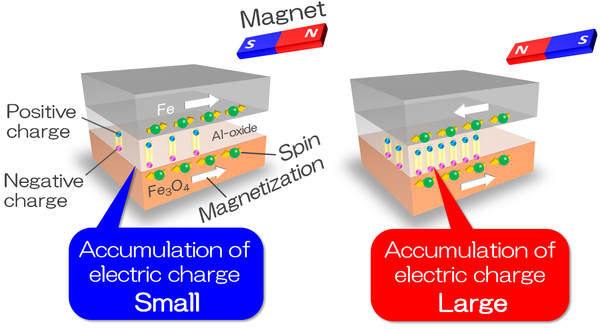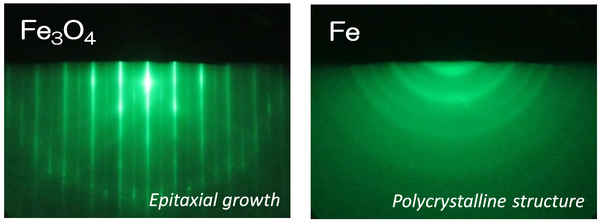The study demonstrates for the first time a new type of magnetocapacitance, a phenomenon that could be useful in the next generation of ‘spintronic’ devices.
Capacitors, electronic components that store and quickly release a charge, play an important role in many types of electrical circuits. They’ll play an equally important role in next-generation spintronic devices, which take advantage of not only electron charge but also spin —the tiny magnetic moment of each electron.
Two years ago, an international team of H. Kaiju and J. Nishii et al. of Hokkaido University and G. Xiao of Brown University showed that by manipulating electron spin at a quantum magnetic tunneling junction —a nanoscale sandwich made of two metal electrodes with an insulator in the middle— they could induce a large increase in the junction’s capacitance.
Now, that same research team has flipped the script on the phenomenon, known as magnetocapacitance. In a paper published in the journal Scientific Reports, they show that by using different materials to build a quantum tunneling junction, they were able to alter capacitance by manipulating spins in the opposite way from “normal” magnetocapacitance. This inverse effect, the researchers say, adds one more potentially useful phenomenon to the spintronics toolkit.

The study shows that anti-parallel spins between two electrodes (Fe and Fe3O4) create more capacitance than parallel spins, which is opposite to what is normally observed.
“It gives us more parameter space to design devices,” said Gang Xiao and Hideo Kaiju. “Sometimes normal capacitance might be better; sometimes the inverse might be better, depending on the application. This gives us a bit more flexibility.”
Magnetocapacitors could be especially useful in making magnetic sensors for a range of different spintronic devices, including computer hard drives and next-generation random access memory chips.
The research was a collaboration between the lab of Hideo Kaiju and Junji Nishii at RIES, the lab of Taro Nagahama at Hokkaido University, the lab of Osamu Kitakami at Tohoku University, and the lab of Gang Xiao at Brown Unversity.
The researchers have been investigating magnetic tunneling junctions for several years. The tiny junctions can work in much the same way as capacitors in standard circuits. The insulator between the two conducting electrodes slows the free flow of current across the junction, creating resistance and another phenomenon, capacitance.
But what makes tunneling junctions especially interesting is that the amount of capacitance can be changed dynamically by manipulating the spins of the electrons within the two metal electrodes. The electrodes are magnetic, meaning that electrons spinning within each electrode are pointed in one particular direction. The relative spin direction between two electrodes determines how much capacitance is present at the junction.
In their initial work on this phenomenon, the research team showed just how large the change in capacitance could be. Using electrodes made of iron-cobalt-boron, they showed that by flipping spins from anti-parallel to parallel, they could increase capacitance in experiments by 150 percent. Based on those results, the team developed a theory predicting that, under ideal conditions, the change in capacitance could actually go as high as 1,000 percent.

The crystal structure of Fe3O4 and Fe electrodes analyzed by RHEED (reflection high energy electron diffraction). The patterns indicate that Fe3O4 has the inverse spinel structure with the same crystal orientation of the MgO substrate, while Fe takes polycrystalline structure. (Hideo Kaiju et. al., Scientific Reports, June 1, 2017)
The theory also suggested that using electrodes made from different types of metals would create an inverse magnetocapacitance effect, one in which anti-parallel spins create more capacitance than parallel spins. That’s exactly what they showed in this latest study.
The researchers used iron for one electrode and iron oxide for the other. The electrical properties of the two are mirror images of each other, which is why they observed this inverse magnetocapacitance effect.
The findings not only suggest a larger parameter space for the use of magnetocapacitance in spintronic devices, they also provide important verification for the theory scientists use to explain the phenomenon.
Now they see that the theories fit well with the experiment, so they can be confident in using the theoretical models to maximize these effects, either the ‘normal’ effect or the inverse effect that they have demonstrated here.
The work was supported by the Japan Society for the Promotion of Science (Grant-in-Aid for Scientific Research (B), 15H03981), the Japanese Ministry of Education, Culture, Sports, Science and Technology (Dynamic Alliance for Open Innovation Bridging Human, Environment and Materials), the Center for Spintronics Research Network at Tohoku University, and the National Science Foundation (DMR-1307056) at Brown University.
Original article:
Media reports:
-
UK
- “Changing spin direction increases capacitance”,New Electronics (Jun. 1, 2017O
- “Scientists Induce Magnetocapacitance Opposite to Normal Capacitance”, Converter News (Jun. 2, 2017)
- “Researchers flip the script on magnetocapacitance”, ResearchSEA (Jun. 5, 2017)<a?
- “Magnetocapacitance Turned Upside Down Offers a New Tool in Spintronics”, EESage.com (Jun. 8, 2017)
-
USA
- “Researchers flip the script on magnetocapacitance”, Phys.org(Jun. 1, 2017)
- “Researchers flip the script on magnetocapacitance”, EurekAlert!(Jun. 1, 2017)
- “Researchers Flip The Script On Magnetocapacitance”, Photonics Online(Jun. 1, 2017)
- “Researchers flip the script on magnetocapacitance”, ScienceDaily(Jun. 2, 2017)
- “Magnetocapacitance Turned Upside Down Offers a New Tool in Spintronics”, IEEE Spectrum(Jun. 7, 2017)
- Germany
- Italy
- Canada
- Australia
Contacts:
Research Institute for Electronic Science
Hokkaido University
Email: kaiju[at]es.hokudai.ac.jp
http://nanostructure.es.hokudai.ac.jp/eng/kaiju_eng.html
Graduate School of Engineering
Hokkaido University
Email: nagahama[at]eng.hokudai.ac.jp
http://www.eng.hokudai.ac.jp/labo/kotai/en/index.html
Institute of Multidisciplinary Research for Advanced Materials
Tohoku University
Email: kitakami[at]tagen.tohoku.ac.jp
http://www.tagen.tohoku.ac.jp/labo/kitakami/E/index.html
Department of Physics
Brown University
Email: gang_xiao[at]brown.edu
https://www.brown.edu/research/labs/xiao/










